Federal Money Laundering at the Duck Races
How Your Tax Dollars Fund Bradley Jackson's Drone Displays While You Go Hungry
Editor’s Note: While you prepare for the Duck Races this weekend, I’m writing this not because I’m against the community activity or community charity. You should know, though, that your efforts don’t achieve the results you expect.
Further, no one person is an institution. No annual event, even with hot air balloons, is a sacred duck that cannot be questioned. If you see Bradley Jackson and the Sertoma Duck Race as above criticism, then you are willfully blind and ignorant. “Doing good” will not protect anyone from investigation. I will not apologize for the research I’ve conducted and the conclusions the research have led me to. I will not apologize for the biases you have that you want me to confirm.
The shell game hiding in plain sight: While families enjoy community festivals, sophisticated wealth extraction schemes operate under the cover of “charity.”
The Nonprofit Con: A Modern Spanish Prisoner
When I was finishing college, I was told to watch a Steve Martin movie titled The Spanish Prisoner. I was young, and it made an impression on me with the layers of complexity that unfolded slowly and deliberately throughout each scene, drawing in the characters. This wasn’t Dirty Rotten Scoundrels.
David Mamet's The Spanish Prisoner is painfully sophisticated because anyone can fall prey to it. For most of us, the shame of the con is so great that we would rather play along than admit it is happening to us. Joe Ross, the everyman, gets drawn into an ornate confidence scheme that turns his success against him. The con works because it hides behind legitimate business transactions—every step appears proper, every document seems genuine, and every participant seems respectable.
Our National Spanish Prisoner confidence game funnels down to our Christian County with federal and state-backed legitimate transactions. Local taxpayer-funded charity network operates on the same principle as regional and national.
Commissioner Bradley Jackson doesn't know he's Joe Ross running a con—he believes he's supporting community partnerships. Donors think they're funding local causes. Volunteers believe they're helping neighbors. Even the Community Foundation of the Ozarks likely believes its own story about "community impact."
However, like all Spanish Prisoner schemes, the con relies on legitimate-looking paperwork that conceals the actual money flow. At the same time, Jackson promotes duck races and food pantries, and $4.2 million flows annually through organizations with undisclosed funding sources. While citizens volunteer their time, those hours generate government welfare credits worth millions. While taxpayers fund "community foundations," their money often disappears into a web of grants with little to no accountability.
The beauty of the con is that everyone becomes complicit. Jackson gets re-elected as a County Commissioner. Nonprofits get funding. Volunteers feel good. And somewhere in Jefferson City, welfare obligations vanish from state budgets while foundation executives collect six-figure salaries. And the separation between church and state grows transparently thin as the Mormon Church buys more land from government investment, farmed and harvested with volunteers from their own heretical church, and distributed by Christians from the true branch of faith.
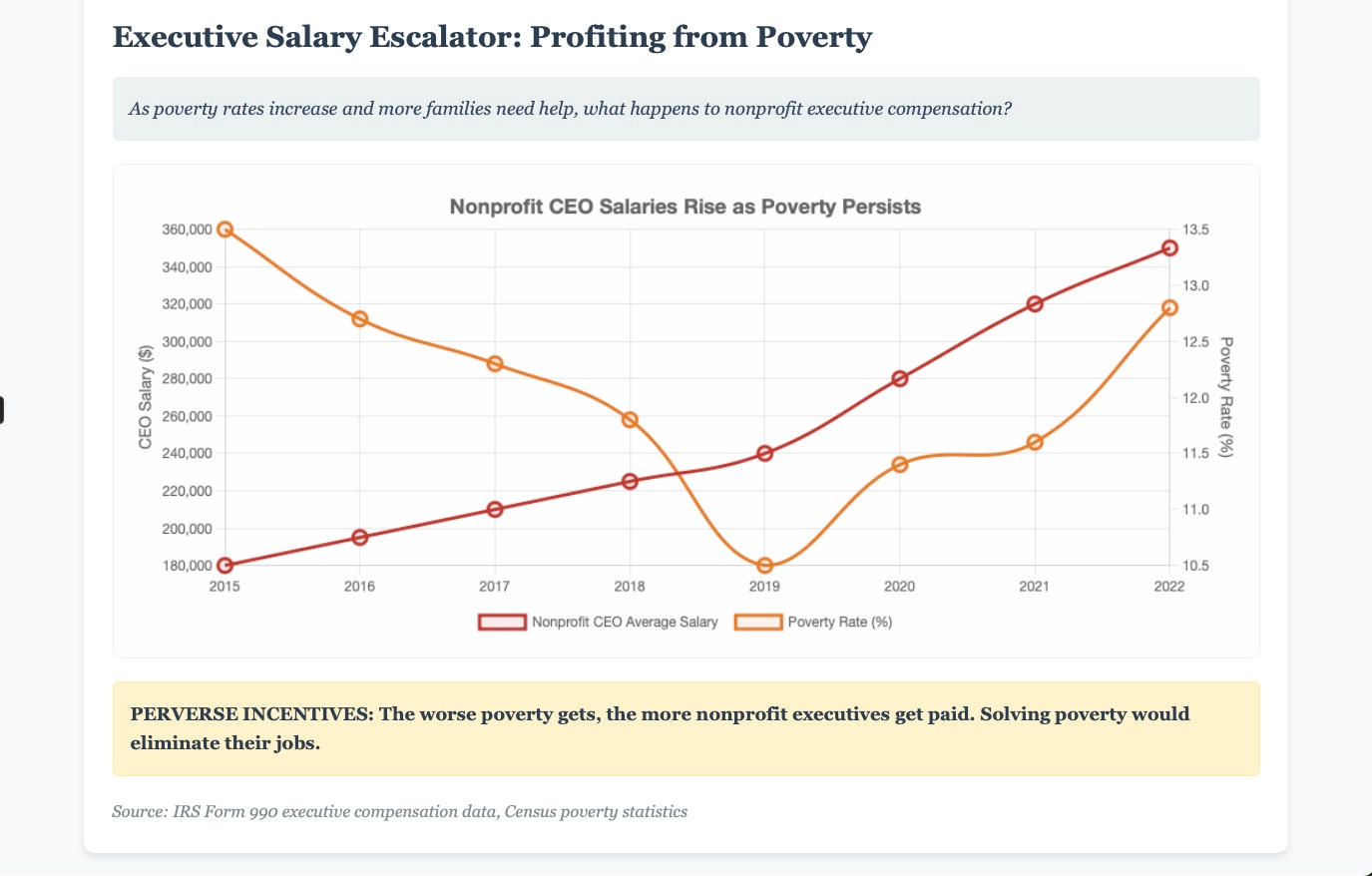
Just like Joe Ross, Christian County taxpayers are funding their own deception, and the paperwork makes it all look perfectly legal.
We talk about the Military Industrial Complex; We need to start talking about the Nonprofit Industrial Complex.
It’s bigger than even DOGE or the Data Republican have reported and their numbers boggle the mind. It’s also not far way in Iran, Ukraine, or Israel. It’s down the street at food pantries and summer duck races.
My investigation exposes a sophisticated system of government money laundering that flows from federal agencies through community foundations to local nonprofits.
Churches and the Government are exploiting volunteer labor while creating the statistical illusion of welfare spending. The system operates like "carbon credits for poverty," using unpaid community volunteers to generate government welfare credits. At the same time, the poor remain poor, and local politicians get re-elected and receive new funding.
My investigation reveals that $427 million flows through the Community Foundation of the Ozarks from upstream government sources, while the Mormon Church operates 1.7 million acres of farmland using exploited volunteer labor. Utah saved $75 million in welfare spending by counting volunteer hours as government expenditures, creating a model now replicated nationwide.
Christian County Commissioner Bradley Jackson used the CCCC Sertoma Duck Race for personal drone promotion, while the "Least of These" food pantry distributed shrinking portions, as your tax dollars subsidized Mormon agricultural profits.
The Chamber of Commerce network coordinates the entire system as government liaison, creating a seamless money laundering operation that spans from federal agencies to local charity events.
The Federal Source - Follow the Money
The Mormon Land Empire
The foundation of this system rests on a massive agricultural operation that most Americans don't realize exists. The Mormon Church owns approximately 1.7 million acres of agricultural land, making it one of the largest institutional landholders in the U.S., with properties valued at nearly $16 billion, including at least $2.3 billion in agricultural holdings.¹
This isn't just land ownership but rather a sophisticated food production system. The Church operates 32 farms, ranches, orchards, and processing facilities, which produced over 100 million pounds of food last year, with 36 million pounds distributed to bishops' storehouses.² The Mormon welfare system produces hundreds of millions of pounds of food annually through its network of farms, ranches, dairies, and food processing facilities, operated largely by volunteer labor.³ They own more land than China and Bill Gates combined.
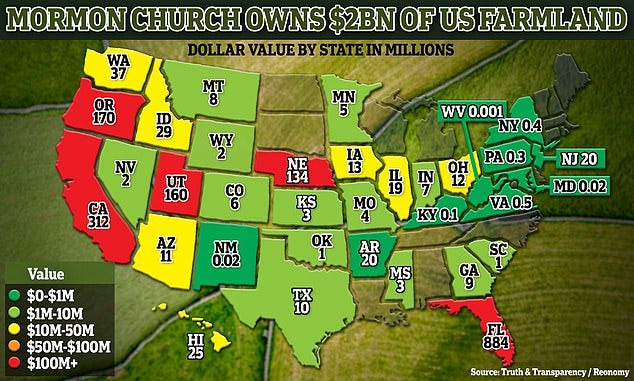
The Muscle
The scale of unpaid labor is staggering. More than 1 million workdays of labor are contributed each year by volunteers in support of welfare initiatives.⁴ Volunteers in Salt Lake City alone donate over 200,000 hours of labor on Welfare Square in a year.⁵ At minimum wage ($15/hour), 1.5 million hours annually equals $22.5 million in free labor. The actual value is much higher since this includes farm management, food processing, transportation, and distribution.
Religious members provide this labor, thinking they're doing "God's work," while subsidizing a massive commercial agricultural operation that sells food back to the government, making the church wealthy and expansionistic. The LDS [Arian Heresy] is becoming an empire. That’s not “God’s work.”
The Government Chedda’
Federal programs like TEFAP (The Emergency Food Assistance Program) complete the circle. The Emergency Food Assistance Program provides 100% American-grown USDA Foods to states, with the Feeding America network receiving over 1.5 billion pounds of TEFAP foods last fiscal year, enough to provide over 1.25 billion meals.⁶
The system works as follows: government buys food from Mormon agricultural operations using taxpayer money, the Mormon Church profits from government contracts while using volunteer labor, food gets distributed to pantries like "Least of These," portions shrink over time as system prioritizes profits over need, and families struggle while their tax dollars subsidized the system that failed them. People in the system can’t complain that their food portions are shrinking and are often told they can only apply to one food pantry at a time or risk losing access to all food pantries.
The Intermediary Revelation
When questioned about their funding sources, Least of These provided a response that perfectly illustrates the Spanish Prisoner structure in action. Michele Pierce, Director of Client Services, confirmed that while they receive no "direct" government funding, they do receive:
TEFAP (The Emergency Food Assistance Program) commodities through Ozarks Food Harvest
CSFP (Commodity Supplemental Food Program) items through Ozarks Food Harvest
Funding through unspecified "grants"
This response reveals the sophisticated pipeline design: Federal programs → Regional food banks → Local "charities" → Volunteer labor. Each layer provides plausible deniability for the next while maintaining the overall government funding structure.
"We do not receive any direct local, state or federal government funding... We do receive a few items in small quantities of TEFAP foods when we order food from Ozarks Food Harvest... We also receive 190 CSFP senior boxes... our funding comes from donations from the public and grants."
—Michele Pierce, Least of These Director of Client Services
This response perfectly illustrates how the Spanish Prisoner operates: technically truthful statements that obscure the government funding pipeline flowing through every level of the operation.
Pierce's emphasis on food safety training (ensuring food won't hurt recipients) versus food quality (freshness and desirability) perfectly captures the system's priorities: regulatory compliance over recipient dignity, cost management over adequate nutrition, and volunteer coordination over genuine assistance.
The organization's response reveals the cognitive dissonance inherent in the system: well-meaning individuals genuinely trying to help families while participating in a structure that benefits upstream corporations and obscures government spending, ultimately compromising both community economic development and the dignity of the recipients.
The Missing Link: Ozarks Food Harvest
Least of These' acknowledgment of receiving federal commodities through Ozarks Food Harvest reveals the crucial intermediary in this laundering operation. Ozarks Food Harvest serves as the regional food bank that transforms direct government programs into "private charity" distribution.
This intermediary structure allows:
Federal agencies are claiming they're supporting "community partnerships."
Regional food banks claim they're helping local charities
Local organizations claim they receive no direct government funding
Politicians to claim they're supporting "faith-based solutions"
Volunteers believe they're engaged in private charity
The genius of this system is that every participant can truthfully describe their role, while the overall operation depends entirely on government funding flowing through multiple organizational layers. It's not deception—it's the sophisticated structure of modern corporate welfare that allows everyone to maintain plausible deniability while extracting maximum value from public resources.
Further investigation into Ozarks Food Harvest's funding sources and distribution networks would likely reveal the complete pipeline from federal agencies to local "private" charities across the region.
The Welfare Wash
How States Avoid Welfare Spending
The states use virtue slavery to build up credits against poverty. Volunteers are told they have to do this to be virtuous by their religious organization, but it’s slavery to the state. The religious organization can either be the LDS Church in Utah, the Baptist Church on the corner, or the Catholic Church. Everyone unknowingly sends out their congregants and parishioners to the same money changers.
The most insidious aspect of this system is how states utilize volunteer labor to generate welfare credits while avoiding actual welfare expenditures. Nearly one-third of states (16 of 51) reported counting nongovernmental third-party expenditures toward their states' required spending level under TANF in fiscal year 2015.⁷
Utah operates a model system where the state has a formal agreement with the Mormon Church, claiming "volunteer hours associated with food production and distribution and other social and humanitarian services" performed by the church as government welfare. This has allowed Utah to avoid spending at least $75 million on welfare over the past decade.⁸ By getting the virtue slaves to give up their time, they also get them to give up providing taxpayer funds to people.
While this may seem logical, consider the economic cost of removing people from the workforce through volunteer hours that they feel they must dedicate to their religion, so that the labor can benefit the state, not the poor, but the state’s coffers. Because, as we know, the state might not spend $75 million on welfare, but has its spending gone down in Utah?
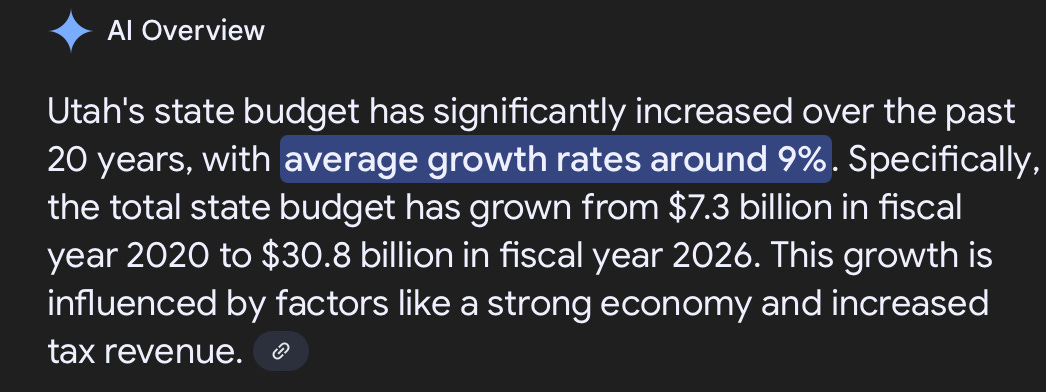
This is what Country Club Republican Welfare has gotten us since Mitt Romney and George Bush. Nonprofit Welfare is funneled down to the poor. Lyndon B. Johnson was a tyrant, and his Great Society was Maoist. At least he didn’t fail to fix poverty by making the rich richer. He just made everyone poorer.
The Credit Crunch
This creates a system identical to carbon credits but for poverty statistics. Carbon credits work when companies pollute, pay for "offsets" elsewhere, then claim to be "carbon neutral" while pollution continues. Volunteer credits work when states have poverty, count volunteer hours as "welfare spending," then claim to be "helping the poor," while poverty continues. Ta-da, poverty solved. Wave your magic food pantry wand, and the nonprofit fairy makes you feel better all over.
The Utah agreement includes "complex formulas," essentially converting volunteer time into dollar amounts that count toward the state's required welfare spending.⁹
The Show-Me Insider
Missouri operates the same system. The number of States that reported counting third-party non-governmental expenditures toward their State MOE spending increased from three States in fiscal year 2007 to 13 States in fiscal year 2011.¹⁰ Evidence shows Missouri already tracks volunteer hours for government purposes, as Master Gardeners of Greene County report volunteer hours because "the figures could have an important impact on the Extension office's future public funding, the decision on continued placement of MU Extension specialists in Greene County, and possibly even grants."¹¹
The Fixer
The Chamber of Commerce Strong-Arming Compliance
You would probably have a lot of friction if the Chamber of Commerce weren’t there to pass out lubricant and blindfolds, so no one knew who they were getting into bed with. They act as the fluffers between the churches, the government, and the nonprofits in their polyamorous relationships.
The Chamber of Commerce system serves as the coordination mechanism for this entire operation. The U.S. Chamber of Commerce is by far the largest lobbying group in the United States, having spent nearly $1.4 billion on lobbying the federal government over the last two decades.¹² The real power lies in how they operate. One of their main functions is to essentially act as a corporate "money laundering" machine, through which companies can anonymously lobby for unpopular policies without facing the public backlash and reputational damage they might encounter if they openly advocated for such things.¹³
The Fixer Saint with a Club
Chambers of Commerce are designated as 501(c)(6) corporations for federal tax purposes. This classification allows chambers of commerce to operate as nonprofit entities while also giving them the authority to represent their members in policy matters.¹⁴ They do business with the government without answering to the people. This creates the perfect vehicle for coordinating government money flows while maintaining the appearance of private business advocacy.
Local Enforcers
At the local level, chambers coordinate efforts among government agencies seeking to meet welfare requirements, community foundations distributing government funds, local nonprofits mobilizing volunteer labor, and politicians taking credit for "community partnerships." Regional, city, and community chambers focus on regional or local issues, often featuring cooperation with local governments.¹⁵ Local politicians work with the local chambers to get votes, be seen, and get campaign funds. Chambers rewards politicians who play by the rules and steer the community their way.
The Seed Money
$427 Million
The Community Foundation of the Ozarks manages $427 million in assets and serves as a vital intermediary between government sources and local organizations. As Data Republican documented, this foundation receives indirect government grants that then flow to local nonprofits, creating the appearance of private charitable giving. They can claim $0 in Taxpayer funds, but if you look upstream, you begin to see the network develop.
This foundation model enables government funding to appear as private charity, federal requirements to be met through "third-party" spending, and local politicians to claim credit for community partnerships, while also allowing actual welfare spending to be avoided while maintaining compliance.
The Storefront
The Community Foundation of the Ozarks doesn't need to fund every organization in its ecosystem directly. By operating alongside organizations like Least of These, which processes millions in undisclosed funding while maintaining 501(c)(3) status, CFO creates a network of legitimate-appearing nonprofits that provide cover for the broader money laundering operation.
This ecosystem approach enables politicians like Jackson to highlight "diverse community partnerships." At the same time, the entire network operates with the same financial opacity and volunteer hour reporting as those that generate government welfare credits.
The Newsboy
My investigation revealed how this system works in practice. The Springfield Daily Citizen claims a $1 million annual operating budget while reaching 35,000 subscribers, operates from Missouri State University facilities (representing an unreported subsidy worth $150,000-250,000 annually), hides donor identities despite claiming transparency, and coordinates with power structures while claiming independence.
Market analysis reveals that their reported budget is insufficient to support their extensive operations and marketing presence, indicating significant unreported subsidies and hidden funding sources.
The Duck and Pony Show
The Commish’ in Lights
Christian County Commissioner Bradley Jackson exemplifies how local politicians exploit this system for personal benefit. Jackson's extensive involvement in the nonprofit network reveals the coordinated nature of this operation. His campaign website proudly states that "Bradley is an active volunteer in Christian County, serving hundreds of volunteer hours every year for local charities."¹⁹
Jackson has served as President of Historic River District Inc. and operates multiple business interests while maintaining deep ties to the nonprofit ecosystem.²⁰ Most significantly, Jackson has served as Chairman of the CCCC Sertoma Duck Race Festival for eight years, describing his enthusiasm: "It's an amazing event for our community. Everybody's down here. Everybody's having a good time. They're smiling, laughing, and hanging out with their friends. That makes me feel good, you know, because it's all about community to me."²¹
When I investigated the application of another nonprofit individual to the Library Board, Jackson called to intimidate me, defending "his nonprofit" work, and bragging about his work with the Chamber of Commerce. I’ve been trying to form a connection in my mind for months between the LDS Church, the Least of These, and Convoy of Hope.
His claim that Sertoma Duck races raised hundreds of thousands of dollars for children made me dig deeper into its finances and connections. Finally, a story I’ve been trying to make sense of became as clear as political messaging, like when Jackson used drones to display his name in lights at the CCCC Sertoma Duck Race, a community charity event funded through the system I was investigating.

Ducks, Dollars, and Drones
The 2024 Sertoma Duck Race Festival became the stage for Jackson's most brazen display of personal exploitation. Near the end of a 15-minute drone show, drones spelled out "VOTE JACKSON" about Christian County Eastern Commissioner Bradley Jackson, who was up for re-election in November.²² This political advertisement occurred during a charity event that benefits four organizations: Care to Learn - Ozark, Children's Smile Center, Least of These Inc., and Dogwood Ranch.
Jackson's wife, Kristin Jackson, writing from the Sertoma Duck Festival email account, attempted damage control: "There was no endorsement intended or implied for any business or candidate that was included in the drone show. There were many political candidates who either had booths or were sponsors of the Duck Race Festival. All candidates and parties that applied for booths or sponsorships were accepted."²³ However, this response failed to address how Jackson, as the event chairman for eight years, allowed his political promotion to be featured during a nonprofit charity event.
Jackson's role as both event chairman and beneficiary demonstrates the systematic exploitation. As he explained his motivation: "Jackson became chairman of the club seven years ago, and wanted to interact with the community in a deeper way than just straight fundraising. Jackson said he decided to delegate to other clubs, allowing them to partner and run their own fundraising events during the duck race."²⁴ This expansion created a larger network of volunteer labor, positioning Jackson at the center of coordination.
Salting the Nonprofit Mine
Jackson's involvement spans multiple interconnected organizations that facilitate the welfare and political laundering system. As the longtime Duck Race chairman, he coordinates with the beneficiaries, including the "Least of These" food pantry, creating a direct connection to the food distribution network that my family experienced up to August 2024.
Jackson described the event's purpose: "This event, particularly this year, has the Children's Smile Center, Dogwood Ranch, Care to Learn Ozark, and Least of These food pantry as the recipients of all of our hard work this weekend."²⁵
His enthusiasm for the community involvement reveals how the system exploits volunteer labor: "I love walking through the crowd, talking to the people, looking at the smiles on the kids’ faces as they're watching the fireworks or watching the Balloon Glow or having fun in the kids. It's just a truly family-friendly event where everybody gets a community comes together and enjoys each other's company, has a great weekend, and they're raising money to help children in our community."²⁶ This sentiment, while appearing benevolent, masks the reality that these volunteer hours likely get reported as government welfare spending while Jackson benefits personally and politically.
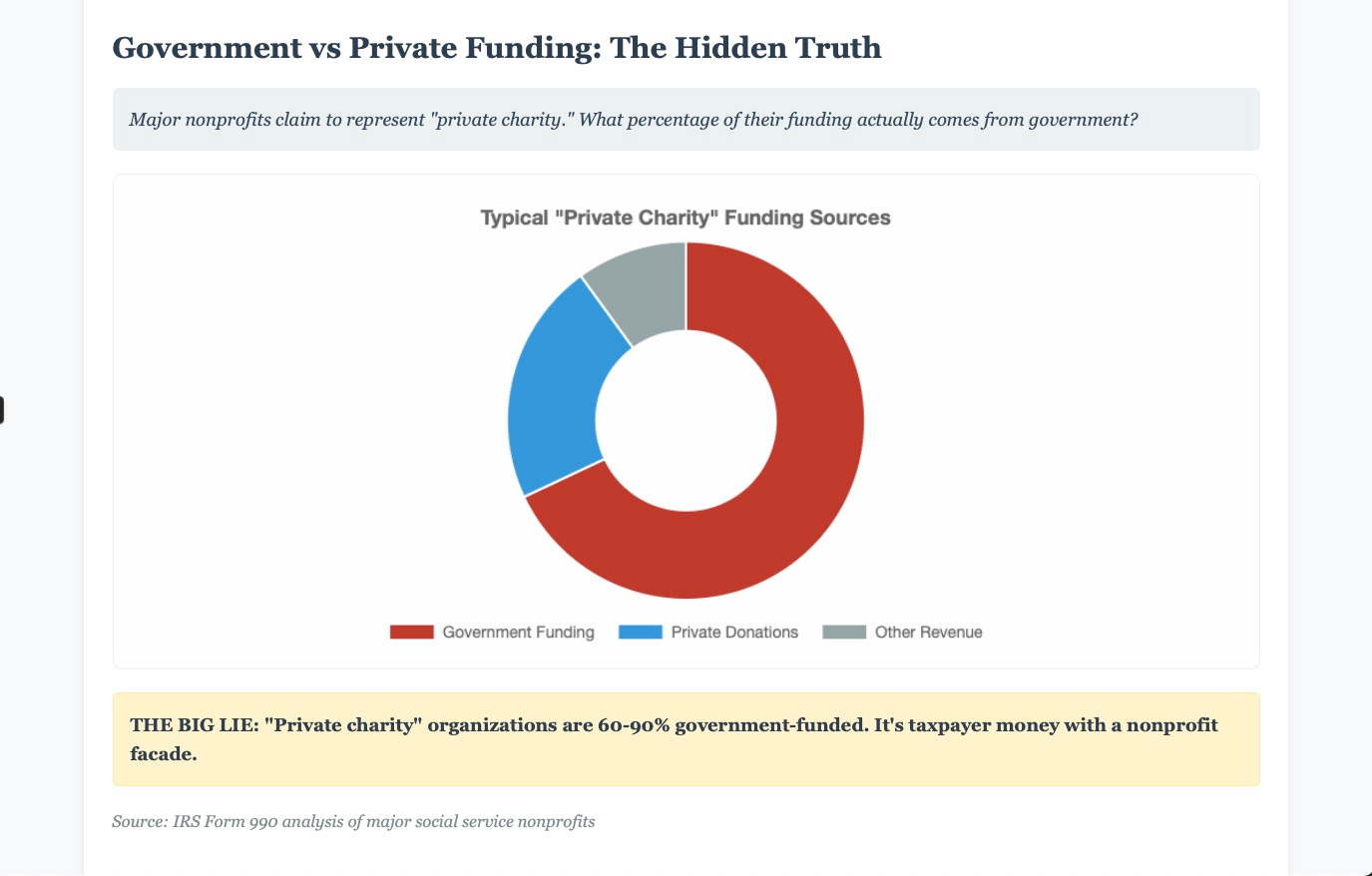
The Federal Pipeline
Federal TEFAP and CSFP programs provide commodities to Ozarks Food Harvest using taxpayer money. Ozarks Food Harvest then distributes this federal food to "Least of These" and similar organizations across the region.
The Plausible Deniability Layer
"Private" charities like Least of These claim no direct government funding while distributing taxpayer-funded commodities. This allows each organization to technically tell the truth about their role while obscuring the overall government funding.
The Volunteer Exploitation
Community volunteers provide free labor, believing they're engaged in private charity. These virtue slave volunteers handle Duck Race setup and food distribution through charitable activities, never knowing that their hours generate government welfare credits.
The Statistical Manipulation
Volunteer hours are reported as government welfare spending, generating TANF credits that allow states to avoid actual welfare expenditures. This creates "carbon credits for poverty"—statistical offsets that make poverty appear to be solved while it persists.
The Personal Benefit
Bradley Jackson receives personal political promotion via drone displays while coordinating the entire operation as event chairman. He profits both financially and politically from a system that exploits volunteer labor and obscures taxpayer funding.
The statistical manipulation works because volunteers believe they're supporting a local charity; the government counts their hours as welfare spending, Missouri receives federal TANF credits, saving millions; Jackson benefits from both the funding system and personal promotion; and poor families receive inadequate assistance from "charity" funded by their tax dollars.
The Duck Shell Game
Financial Opacity and Ecosystem Coordination
"Least of These Inc" reported $14.8 million in revenue over five years (2018-2022), with $4.2 million in 2022 alone. When contacted, they confirmed receiving federal TEFAP and CSFP commodities through Ozarks Food Harvest, as well as funding from unspecified "grants," revealing the exact intermediary structure that obscures government funding sources.
This funding pipeline serves multiple functions in the broader system. While "Least of These" claims no "direct" government funding, their acknowledgment of federal food programs through intermediaries demonstrates how the system creates plausible deniability at each layer, provides legitimacy and cover for the CFO's operations. When Commissioner Jackson promotes the Duck Race benefiting "Least of These," he's endorsing an organization that operates with the same funding secrecy that characterizes the entire network. [Dogwood Ranch had blank Schedule A and Bs.]
The pattern is clear: $4.2 million flows through "Least of These" annually with zero donor transparency, while Jackson coordinates "community partnerships" that generate volunteer hours, which count toward government welfare credits. This creates plausible deniability—Jackson can claim he's supporting "local charity" while participating in a system designed to avoid welfare spending through statistical manipulation.
The Reading Cartel
The intimidation phone call from Jackson revealed another layer of the system when he defended his planned appointment of a Lions Club president to the Library Board. Jackson's involvement in library board appointments illustrates how the nonprofit network extends its influence into information and educational institutions. Christian County Commissioners have the authority to make library board appointments,²⁷ creating another mechanism for ensuring systemic coordination across institutions.
This connection explains Jackson's defensive reaction when I questioned nonprofit trustworthiness. The library system represents another node in the money laundering network, potentially receiving federal funding through various programs while coordinating with the Chamber of Commerce and the community foundation system. Jackson's control over library board appointments ensures that the institution remains aligned with the broader network of corruption.
We’ve been concerned that the Board has been receiving criticism from local voters, but as Jackson informed me, some of the most virulent emails have come from supporters of the Friends of the Library. Perhaps they have been pressured by the Chamber of Commerce to make Christian County more progressive to earn more points towards their imaginary ESG scores. The world will burn to make white Karens feel good about their box wine regrets.
The Patsies
Personal Experience of System Failure
The most damning evidence comes from experiencing this system as a recipient. My family relied on the Least of These food pantry for over a year, and the portions shrank each month until we had to supplement with purchased food or help from family heavily. When confronted about this experience, the organization emphasized their food safety procedures while acknowledging they receive federal commodities through Ozarks Food Harvest—confirming that families receive government-funded food while believing they're recipients of private charity.
The cruel irony is that we still paid taxes that funded Mormon agricultural operations, Mormon farms produced food using volunteer labor, the government bought Mormon food with our tax dollars, Least of These distributed inadequate portions, and we bought additional food. In contrast, our tax money subsidized Mormon profits, and politicians took credit for "community support" while we went with less, as we didn’t qualify for food stamps.
We were grateful, but during a time of hardship, each trip to the food pantry felt more distressing than the last, as we were working poor, struggling to care for our family, just like nearly everyone else in line, from senior citizens to families with young children. Don’t you dare question that a charity might be balanced in such a way as to care little about the recipients while enriching the people at the top of the national funneling system.
Backbreaker
This isn't incompetence; instead, it operates by design. The system works exactly as intended to maintain poverty while creating a statistical illusion of addressing it, exploit virtue slave labor to generate government credits, enrich connected interests, including the Mormon Church, local politicians, and Chamber members, avoid actual welfare spending while claiming compliance, and silence critics through intimidation and institutional pressure.
The Legitimacy Reinforcer
The Convoy of Hope - Mormon Partnership:
The Money Pipeline:
I attended a packing event at Convoy of Hope before Christmas with my college-age class. I wanted to do a mission work with them, and they suggested it. While we packed a lot of crates, one pallet had a sign like the one below. In each ziploc bag was a letter from the LDS church, going out with toiletry supplies being packed by Christians.
We were doing mission work for the LDS church. I was appalled. People think rebellion is a terrible quality for a Christian. Rebellion led me to grab this off the pallet when everyone around me wanted to ignore the problems. I’ve been on this story since then, struggling to understand how the pieces fit together. It’s been like the Spanish Prisoner in complexity, trying to solve this.
In 2020, Latter-day Saint Charities partnered with Convoy of Hope to provide 30 million meals to feed school children in nine developing countries and territories EdMggreene. The Church provided $5.5 million of cash donations to key relief agencies in the U.S., including Convoy of Hope (Springfield, Missouri), with Convoy of Hope CEO Hal Donaldson stating: "This generous gift came at a pivotal time. Convoy of Hope is well on its way to reaching the goal of delivering 10 million meals to those hit hardest by the coronavirus," TANF Maintenance of Effort Requirement.
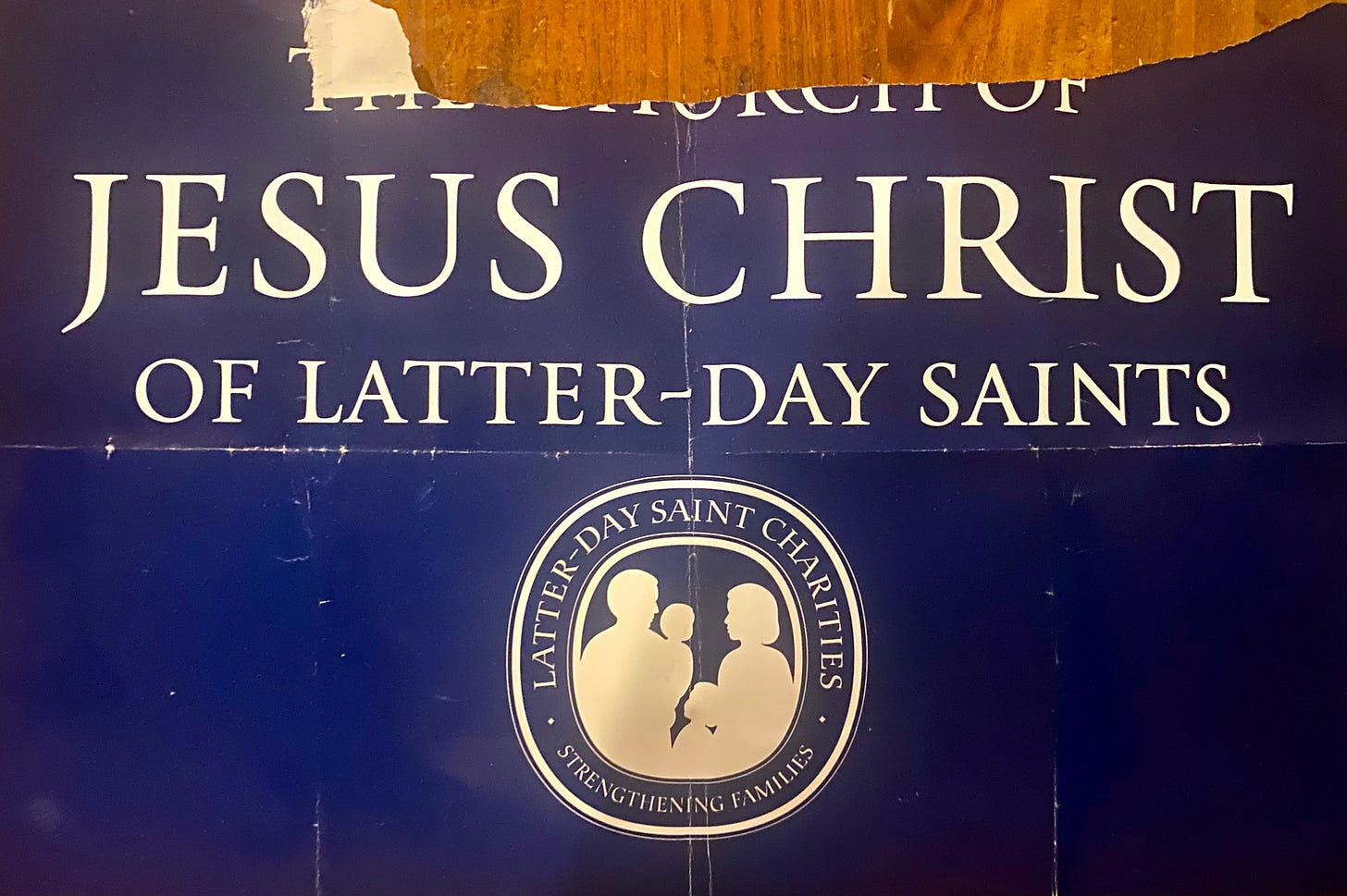
The Partner
The Church has had a long-standing partnership with Convoy of Hope, which meets the TANF Maintenance of Effort Requirement. This isn't a recent cooperation, but rather an established relationship where Mormon funds directly support Convoy of Hope operations.
The Hunger
Convoy of Hope Procurement Director Paul Holzer explained: "Our program method ensures the food being distributed is used in a responsible and strategic way that invests in the lives of those eating and does not create dependency or hurt local markets," NccpAcf. Another critical partner in the process is Feed My Starving Children (FMSC), an organization that provides the meals that Convoy of Hope distributes. NccpMo.
The Chamber’s Web
Jackson's Entanglements
Jackson's bragging about his Chamber of Commerce work reveals how this coordination happens. It all flows back to the Chamber, which brings together all these disparate groups, including the government, nonprofits, and NGOs. The Chamber is the Fixer.
The Chamber serves multiple functions in financial coordination by tracking volunteer hours from member businesses and community events, reporting activities to state agencies for TANF credit calculation, facilitating partnerships between government and nonprofit sectors, and promoting "economic development" that benefits member businesses.
The Chamber also provides political protection by providing institutional legitimacy for government money laundering, creating talking points about "public-private partnerships," generating campaign support for cooperative politicians, and offering plausible deniability for controversial policies.
The National Network
The U.S. Chamber spent $76,280,000 lobbying in 2024¹⁶ and was the second largest dark money spender overall in the 2016 cycle.¹⁷ This massive spending creates a coordinated national network where federal policies are shaped to benefit the system, state implementation is standardized across the country, local chambers receive guidance on operating procedures, and politicians receive support for maintaining the system.
The Mormon Empire
Land, Not Food
While CCCC Sertoma may not have direct Mormon connections, the Mormon agricultural empire provides the template and infrastructure for the entire system. The Mormon Model includes massive land ownership of 1.7 million acres, volunteer labor exploitation of 1+ million hours annually, government contracts through TEFAP food purchases, statistical manipulation via Utah's welfare credit model, and religious justification for unpaid labor.
National replication occurs when other organizations adopt similar models, including land ownership through various nonprofits and foundations, volunteer coordination through service organizations, government contracts disguised as charitable partnerships, statistical reporting that obscures actual money flows, and ideological justification for system participation.
Hunger as Good
Mormon farms likely supply significant portions of the food reaching pantries nationwide through TEFAP distribution.¹⁸ This means families across the country experience the same cruel cycle of paying taxes that fund Mormon agricultural subsidies, receiving inadequate assistance from food produced with their tax dollars, having to supplement with additional purchases, and generating statistics that show successful "charity" while struggling.
Conclusions and Implications
A Personal Note from a Patsy
As someone who experienced this system's failure firsthand—watching food portions shrink at "Least of These" while my tax dollars subsidized Mormon profits—I can attest that this isn't abstract policy analysis. This is about families going hungry while their money funds a system designed to enrich the connected few.
When Bradley Jackson put his name in lights with drones at a charity event, he wasn't just being arrogant. He was advertising his complicity, using taxpayer-funded systems for personal political promotion while the people who fund those systems struggle to feed their families. Even if taxpayers indirectly provide the money at a certain level, it has been channeled into our community to change our behaviors and influence our politics.
The volunteer hours at that Duck Race weren't just community service. They were unpaid labor that generated government welfare credits, allowing the state to avoid actual welfare spending while politicians like Jackson took personal credit and financial benefit.
This system doesn't help the poor—it exploits them twice: first by taking their tax money to fund federal commodity programs, then by using their community spirit against them to distribute those same taxpayer-funded commodities while claiming it's private charity. When organizations like Least of These receive federal food through intermediaries while maintaining they receive no government funding, they're not lying—they're participating in a system specifically designed to obscure the government funding that flows through every level of the operation.
Every volunteer hour reported to the government as welfare spending is an hour stolen from the poor who need that actual assistance. Churches must stop sending their congregants to off-site food pantries and instead host their own that don’t report to the government or buy from the LDS church.
It's time to expose the full scope of this federal money confidence scheme and hold accountable those who profit from poverty while claiming to solve it.
Sources and Citations
"New database gives widest look ever at LDS Church landholdings," Salt Lake Tribune, April 6, 2022
"Inside Church Headquarters: A glimpse into the Church's welfare and humanitarian efforts," Church News, January 10, 2024
"Mormon Welfare System," Philanthropy Roundtable, December 18, 2022
"The Church of Jesus Christ of Latter-day Saints and World Food Program USA," World Food Program USA, February 7, 2024
"LDS Welfare Cannery," MormonWiki
"The Emergency Food Assistance Program (TEFAP)," Feeding America Action, January 8, 2025
"Temporary Assistance for Needy Families: Update on States Counting Third-Party Expenditures toward Maintenance of Effort Requirements," U.S. GAO, 2016
"Utah Makes Welfare So Hard to Get, Some Feel They Must Join the LDS Church to Get Aid," ProPublica, March 11, 2024
Ibid.
"Temporary Assistance for Needy Families: More States Counting Third Party Maintenance of Effort Spending," Peer TA Network, November 5, 2015
"Hours Reporting," Master Gardeners of Greene County
"Who Does the US Chamber of Commerce Really Represent?" U.S. News, October 22, 2015
"Political Spending," U.S. Chamber Watch, February 1, 2018
"Chamber of Commerce and Board of Trade," Internal Revenue Service
"Chamber of Commerce: What It Is, What It Does, and How It Makes Money," Investopedia
"US Chamber of Commerce Lobbying Profile," OpenSecrets, 2024
"Political Spending," U.S. Chamber Watch, February 1, 2018
Based on TEFAP distribution analysis and Mormon Church agricultural holdings documentation
"Bradley Alan Jackson for Christian County Eastern Commissioner," Campaign Website
"A Conversation With … Bradley Jackson," Springfield Business Journal, May 14, 2018
"Sertoma Duck Race Festival returns to Ozark," KRZK 106.3, June 25, 2024
"Ozarks nonprofits reassert political neutrality after drone show with campaign message," Yahoo News, July 6, 2024
Ibid.
"Glowing hot air balloons and carnival fun planned at Finley River events," Springfield Daily Citizen, June 9, 2022
"Sertoma Duck Race Festival kicks off Friday night in Ozark, Mo.," KY3, June 16, 2023
Ibid.
"Library Board of Trustees," Christian County Missouri, November 8, 2024






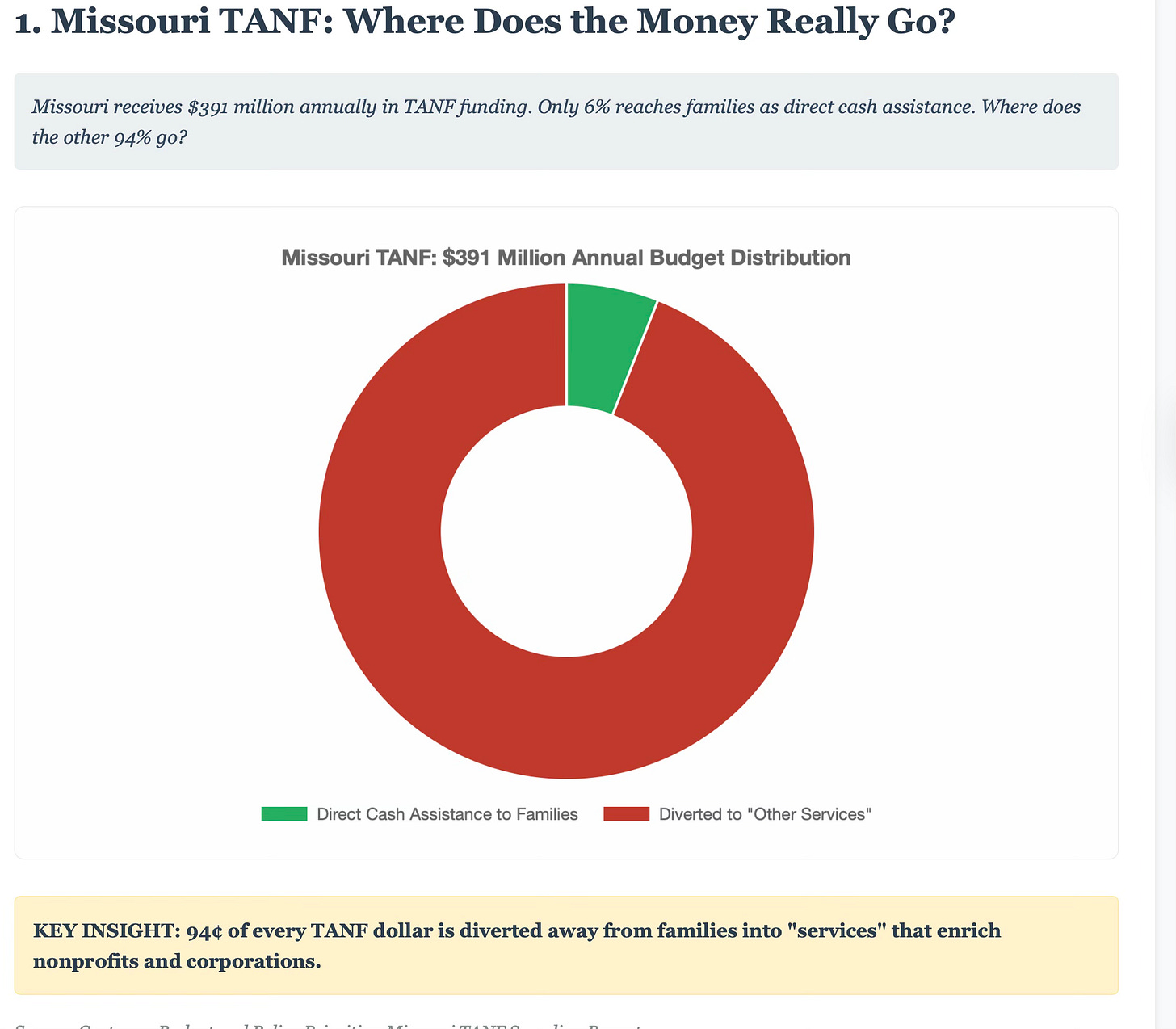
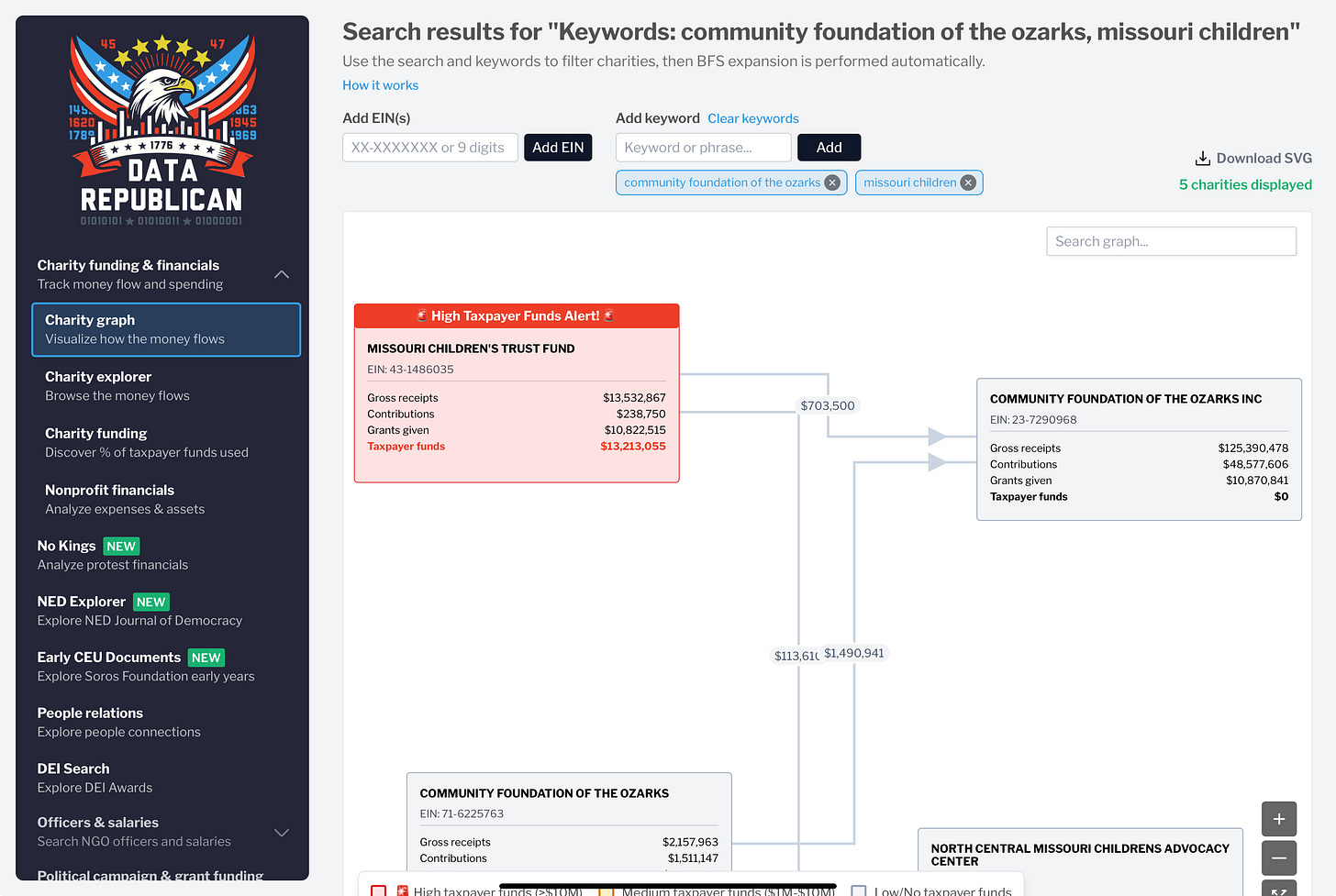
What a banger! First thought that came to mind learning that Convoy of Hope center in Republic was going to have a 50,000 sq ft food mfg facility was, "Who is supplying all that food?"
It's like unraveling the Enron of food banks.